hello@varunabiotech.com - GST NO. : 09AABCV7390J1ZS
- Send Email
Our Solutions
Sugar
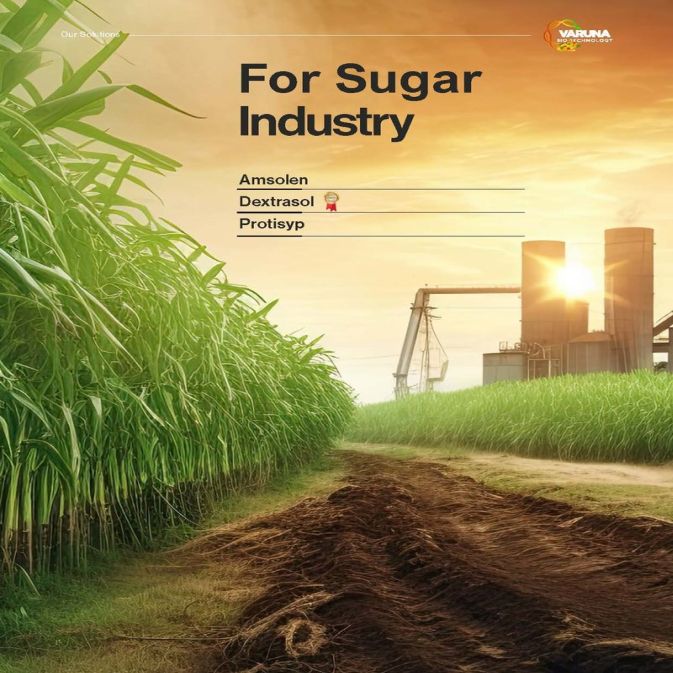
Higher yields, lower waste. The future of sugar processing.
Worldwide 1,889,268,880 tonnes of sugarcane are produced per year. Brazil is the largest sugarcane producer in the world with 768,678,382 tonnes production volume per year. India comes second with 348,448,000 tonnes yearly production.Brazil and India produce together 59% of World's total, hence sugar industry isa big business in India. Around 525 mills produced more than 30 million tonnes of sugar which lasted from October to April (In India). There are two major sugar producing states in India that is U.P and Maharashtra.
Biotechnology increases the efficiency of sugar processing and energy saving by virtue of hydrolytic enzymes.
Amsolen: Is a medium to high temperature acid tolerant Alpha Amylase for Endo hydrolysis of (1→4)-α-D-glycosidic linkages in polysaccharides containing three or more (1→4)-α-linked D-glucose units. Amsolen is obtained by the controlled fermentation of genetically modified strain of Bacillus Licheniformis. Amsolen hydrolyses starch to increase sugar recovery and improve overall performance.
Dextrasol: Dextrasol is a fungal dextranase 1,6-alpha-P-glucan6-glucanohydrolase which is obtained by the controlled solid-statefermentation of Penicillium acculeatum. Dextran’s are undesirable compounds produced by microorganism present in the soil. Dextrasol reduces dextran in sugar processing and in end product to increase sugar recovery and improve overall performance.
Protisyp: Protisyp is an optimized blend for sugar juice preservation. It prevents the growth of filamentous bacteria and is superior to the chemical biocides as it is non-toxic and environment friendly.
Molasses Ethanol
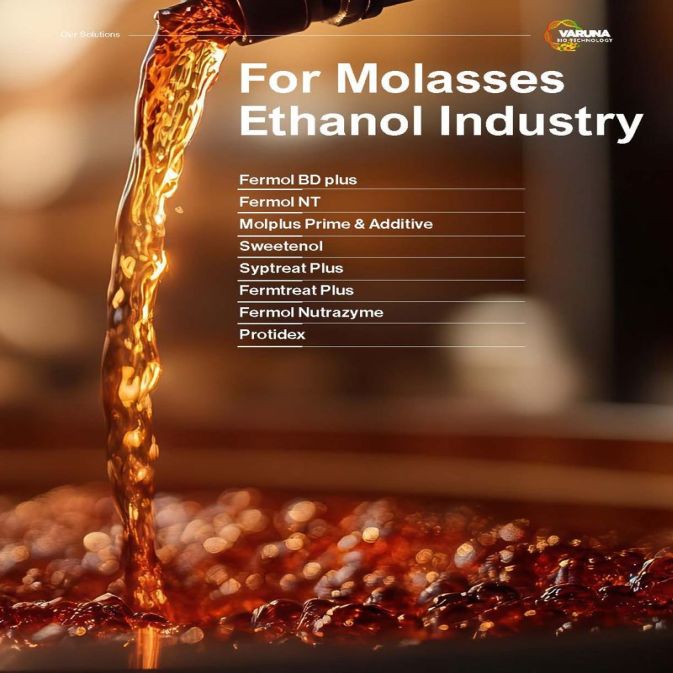
Enhancing fermentation efficiency for higher Ethanol yields
The global ethanol market size was valued at US$ 89.1 billion in 2019 and is anticipated to register a compound annual growth rate (CAGR) of 4.8% from 2020 -2027, this was the situation before Pandemic. The demand of the product is increased enormously by growing uses of the product.
The application of ethanol as a Biofuel is one of the major market drivers. Ethanol is blended with gasoline up to concentration of 10% and 15% to tackle the problem of rising air pollution caused by automobiles.
Ethanol can be manufactured by both natural as well as petrochemical feedstocks. In natural process natural sugars are fermented in the presence of yeast. Government of India has taken various initiatives to produce ethanol from molasses and cane juice.
Enzymes have been widely used in distilleries for various benefits like increasing the yield and efficiency, streamlining the process, eliminating bacterial contamination which thus lower by-products and improve sprit quality.
Our Solution forDistillery:
Fermol BD+: Fermentation Booster For Molasses And Cane Juice Distillery: Our customise enzymes-based formulation increases alcohol/ethanol production and improves the overall efficiency of the plant.
FermolNT: Nutritive Formulation for Yeast. Fermol NT has the inimitable combination of enzymes and nutrients required by yeast for faster growth and higher yield.
Mol+Prime and Additive: Mol+ Prime and Additive is used for preservation of molasses during storage. Our specialized enzymatic formulations preserve the valuable sugars in the molasses during storage.
Sweetenol: Cane juice/Syrupto Alcohol. Sweetenol is a blend of various speciality enzymes for its application in the continuous fermentation process of cane syrup to increase fermentation efficiencies.
Fermtreat +: Biocide for Recycled Process Streams. Our unique combination of enzymes replaces standard biocides without any adverse effects on the environment.
Fermol Nutrazyme: Urea Replacement Enzyme for Distillery. Our specially formulated blend of enzymes and micronutrients assists in replacing the use of urea in distilleries.
Protidex: Protidex is an enzymatic Biocide for molasses Fermentation. Bacterial contamination is a common problem of distillery and results in consumption of sugar faster than yeast to produce organic acids instead of ethanol. The R&D team of Varuna has developed special enzyme blend Protidex for efficient management of bacterial contamination.
Biofuel & Bioethanol
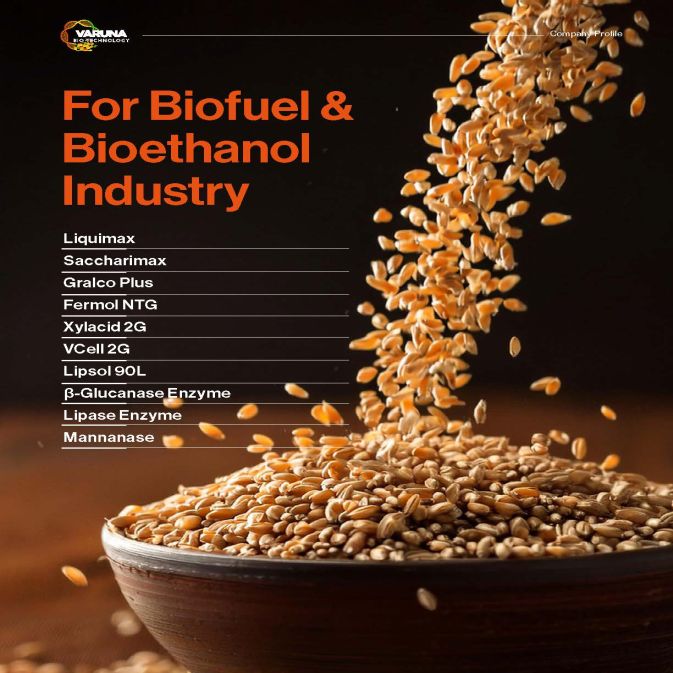
Transforming Biofuel & Bioethanol production with enzymatic innovation
Second-generation bioethanol is a sustainable energy source that can be produced from different renewable materials. However, there is a challenge we must overcome to significantly enhance bioethanol production: the hydrolysis of lignocellulosic biomass to fermentable sugars. Thus, suitable Cellulase / Hemicellulase enzymes are used to effectively degrade and convert this lignocellulosic waste while amylases convert starches into sugar for biofuel fermentation.
Liquimax: Liquimax is a high temperature Alpha Amylase which converts Starch into dextrin i.e., used in liquification of grain.
Saccharimax: Saccharimax is a Glucoamylase enzyme and is useful for converting Dextrin into glucose.
Gralco +: Fermentation Booster for Grain Distillery. Our customised enzymes-based formulation increases alcohol/ethanol production and improves the overall efficiency of grain-based distillery.
Fermol NTG: Fermol NTG is a yeast nutrient for grain-based distillery. It is a proprietary blend of yeast nutrients complex that promotes and sustains yeast cell propagation and viability.
Xylacid 2G: It is a Xylan hydrolyzing Xylanase enzyme produced from a modified strain of Aspergillus species. Xylans are polysaccharides composed of β-1, 4- linked Xylo pyranose units. They are one of the major constituents of plant cell walls and account for more than 30 % of the dry weight of terrestrial plants. The enzyme falls into the category of endo- β-1, 4-xylanase which is of prime importance for hydrolysis of Xylan polymers in Cereal Grains and Lignocellulosic Biomass. The enzyme breaks Xylan to short chain xylo-oligosaccharides of varying lengths.
VCell 2G: is a Cellulase complex enzyme having endoglucanases, β-glucosidases, cellobiohydrolases for the hydrolysis of lignocellulosic waste. These enzymes hydrolyze the lignocellulosic waste to release the glucose suitable for fermentation.
Lipsol 90 L: Lipsol is a fungal Lipase produced from non-GMO strain of cylindracea sp. Lipsol aids in biodiesel production by catalysing the transesterification of oils.The enzymatic process of transesterification is an ecofriendly and economic process in the production of Bio-Diesel.
β-Glucanase: β-Glucanases are a class of enzymes that hydrolyse β-1,3and β-1,4 linkages in β-glucans—polysaccharides found in cereals, fungi, andcell walls of yeast and plants. These enzymes are essential in various industries for improving viscosity control, nutrient availability, and processing efficiency.
Lipases: Lipases are hydrolytic enzymes that catalyse the breakdown of triglycerides into glycerol and free fatty acids. These enzymes exhibit broad substrate specificity and operate effectively at oil–water interfaces, making them valuable in industries that deal with fats and oils. Lipases also support esterification and transesterification reactions, expanding their utility into biosynthesis and green chemistry.
Mannanase: Mannanase is a hydrolytic enzyme that specifically breaks down mannans, a group of complex polysaccharides found abundantly in plant cell walls, especially in legumes, palm kernel, guar gum, and copra meal.Classified primarily as endo-β-1,4-mannanase, it cleaves the internal β-1,4-mannosidic linkages in the backbone of mannans, glucomannans, and galactomannans.
This enzyme plays a vital role in various industries by improving process efficiency, enhancing nutrient availability, and reducing anti-nutritional factors in feed and food matrices. Its use contributes to clean-label, sustainable processing solutions.
Food
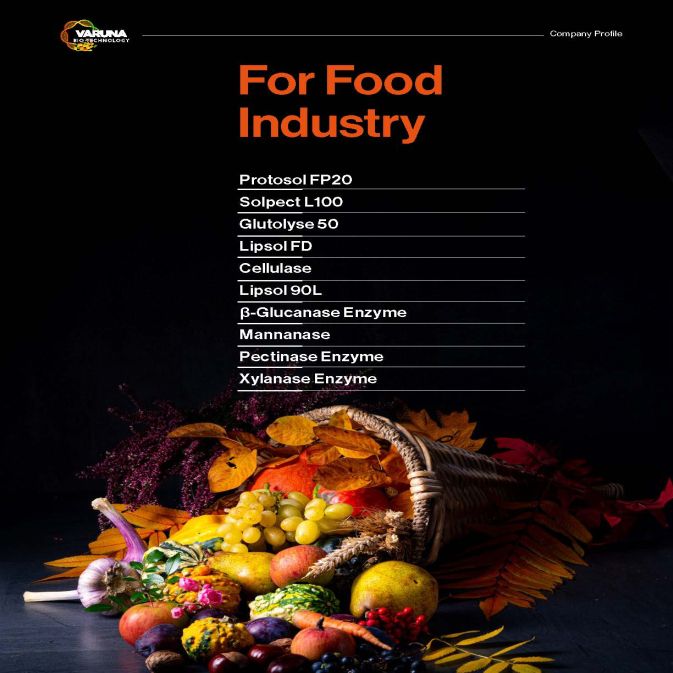
Enhancing food quality & sustainability with biotechnology
Varuna Biotech is revolutionizing the food industry with advanced enzymatic solutions designed to enhance processing efficiency, quality, and sustainability. With a strong focus on innovation, the company offers specialized enzymes catering to applications in dairy, baking, brewing, fruit juice extraction, and protein hydrolysis.
Protosol FP20: Protosol FP20 is the neutral protease for food processing.It is a fungal protease/peptidase complex produced by SSF technique using Aspergillus flavus(GRAS) and has both endopeptidase and exopeptidase activities.
Solpect L 100: Solpect L 100 is a pectinase complex widely used in Juice Extraction clarification and modifying fruit juices. This enzymes-based formulations is also useful for higher juice extraction from fruits and for reducing viscosity in order to avoid the pulpto gelatinize during concentration.
Glutolyse50: Glutolyse 50 is an endopeptidase preparation produced from non-GMO strain of Bacillus subtillis designed especially for Gluten modification by SSF. It is a food grade protease with broad substrate specificity, able to efficiently hydrolyze most of the soluble proteins.
Lipsol FD: Lipsol FD is a fungal food grade lipase for flour improvement and is produced by the controlled fermentation of an environmentally friendly non-GMO fungal species. Lipsol FD displays broader substrate specificity I.e. it can release fat breakdown products from many different components of wheat fat.
Cellulase: Cellulase is a food grade acid cellulase derived from a NON-GMO strain of Trichoderma reesei capable of converting cellulose to glucose. This cellulase complex consists of both exoglycanase and endoglucanase which directly attack cellulose derivatives and native cellulose.
Lipsol 90L: Lipsol 90L is a fungal lipase for oil and food application. Lipsol 90 L is a food grade lipase produced from NON-GMO fungal species of candida cylindracea by SSF. Lipsol 90L has an application in hydrolysis of oil, food processing and feed supplements.
β-Glucanases: β-Glucanases are a class of enzymes that hydrolyse β-1,3 and β-1,4 linkages in β-glucans—polysaccharides found in cereals, fungi, and cell walls of yeast and plants. These enzymes are essential in various industries for improving viscosity control, nutrient availability, and processing efficiency.
Mannanase: Mannanase is a hydrolytic enzyme that specifically breaks down mannans,a group of complex polysaccharides found abundantly in plant cell walls, especially in legumes, palm kernel, guar gum, and copra meal.Classified primarily as endo-β-1,4-mannanase, it cleaves the internal β-1,4-mannosidic linkages in the backbone of mannans, glucomannans, and galactomannans.
This enzyme plays a vital role in various industries by improving process efficiency, enhancing nutrient availability, and reducing anti-nutritional factors in feed and food matrices. Its use contributes to clean-label, sustainable processing solutions.
Pectinases: Pectinases are a group of enzymes that catalyse the degradation of pectic substances, particularly pectin, a structural polysaccharide found in the middle lamella and primary cell walls of plants. Pectinases include polygalacturonase, pectin lyase, and pectin esterase, and are essential in industries requiring the clarification, extraction, and processing of plant-based materials.
Xylanase: Xylanase is a class of hydrolytic enzymes that catalyse the degradation of Xylan, a major hemicellulosic component of plant cell walls, into xylose and xylo-oligosaccharides. Xylanases enhance process efficiency and product quality in a wide range of industries by enabling better fibre modification, improved digestibility, and cleaner processing.
Poultry & Animal feed

Boosting animal growth & immunity with precision enzymes
The basic composition of feed for animals is plants, cereal grains and vegetable derived proteins. Most used feed additives are cereal grains and lignocellulosic materials which are primarily composed of Starch, Non-Starch polysaccharides (Hemicellulose matter such as Beta-Glucans, Xylans / Arabino Xylans, Cellulose etc) and Proteins. Monogastric animals are unable to facilitate complete digestion of these items due to anti-nutritional factors, which in the case of animal feeds would be Non-starch Polysaccharides (NSP) due to their soluble nature which causes swelling and increases the viscosity in the intestine of the animals.
Addition of enzymes such as B-Glucanase, Xylanase and Cellulase / Hemicellulase in animal feed enables breakdown of these NSP elements solving the above problems faced by feed industry. The benefits achieved are increased Metabolizable Energy and access to proteins in the feed, enhancing protein utilization. Another enzyme which is used in feed industry is Phytase, used to digest plant phytate to give phosphorus, an important mineral for poultry.
Phosfyt 50KG: Phosfyt is a phytase enzyme which is used to unleach the organic phosphorus in animal and poultry feed.This in an advanced Thermostable Phytase Enzyme available in Powder, Granules and in Liquid form.
Phosfyt 10KL: Phosfyt 10KL is a stabilized liquid phytase for poultry. Phosfyt 10 KL is a superior acting and stable phytase developed by R & D team of Varuna from aspecially induced NON-GMO fungal strain. Phosfyt 10 KL also contains other useful side activities for hydrolysis of cellulose, Beta glucans and xylans which make the preparation very efficient in releasing of bound organic phosphorus in the plant materials used in feed and helps in extracting higher energy from the feed ingredients.
BP zyme +: BP zyme + is an optimum Enriched and balanced blend of enzymes fortified with probiotics. BP zyme + provides adequate activities of cellulose, Xylanase, Amylase, Glucoamylase, Pectinase, Protease, Phytase, BetaGlucanase, Lipase fortified with Bacillus subtillis and Lacto bacillusacidophillus.
Encaf+: Encaf+ is a fortified enzyme compound for cattle feed supplementation. Encaf + is a rational combination of enzymes fortified with valuable herbal extracts designed and developed to enhance fiber digestibility and to optimize utilization of all essential nutrients from feed to boost up milk yield with improved fat profile.
Elyte VET: Elyte Vet is a blend of electrolytes in optimum concentration to maintain the required osmotic pressure through which the acid -base equilibrium is maintained. It is a powerful caretaker for veterinary during heat stress and improves immunity to relieve various stress conditions.
Hepabex VET: Hepabex VET is a potent hepatic protector. It is a unique combination of herbs with lipotropic. Liver stimulant, diuretic and Anti-diarrheal activity. The synergistic blend of herbs in Hepabex vet helps to prevent, control and treat FLS, Haemochromatosis, Autoimmune liver disorder, Carcinogenic growth, Gout, hepatomegaly, Splenomegaly, Ascites, Diarrhea, renal Dysfunction, Viral hepatitis etc.
β-Glucanases: β-Glucanases are a class of enzymes that hydrolyse β-1,3 and β-1,4 linkages in β-glucans—polysaccharides found in cereals, fungi, and cell walls of yeast and plants. These enzymes are essential in various industries for improving viscosity control, nutrient availability, and processing efficiency.
Cellulases: Cellulases are enzymes that hydrolyse β-1,4-glycosidic bonds in cellulose to release glucose and cello oligosaccharide. Cellulases are a group of hydrolytic enzymes that break down cellulose, the major structural component of plant cell walls, into simpler sugars like glucose.
Mannanase: Mannanase is a hydrolytic enzyme that specifically breaks down mannans, a group of complex polysaccharides found abundantly in plant cell walls, especially in legumes, palm kernel, guar gum, and copra meal.Classified primarily as endo-β-1,4-mannanase, it cleaves the internal β-1,4-mannosidic linkages in the backbone of mannans, glucomannans, and galactomannans.
This enzyme plays a vital role in various industries by improving process efficiency, enhancing nutrient availability, and reducing anti-nutritional factors in feed and food matrices. Its use contributes to clean-label, sustainable processing solutions.
Pectinases: Pectinases are a group of enzymes that catalyse the degradation of pectic substances, particularly pectin, a structural polysaccharide found in the middle lamella and primary cell walls of plants. Pectinases include polygalacturonase, pectin lyase, and pectinesterase, and are essential in industries requiring the clarification, extraction, and processing of plant-based materials.
Xylanase: Xylanase is a class of hydrolytic enzymes that catalyse the degradation of Xylan, a major hemicellulosic component of plant cell walls, into xylose and xylo-oligosaccharides. Xylanases enhance process efficiency and product quality in a wide range of industries by enabling better fibre modification, improved digestibility, and cleaner processing.
Detergent

Advanced bio-surfactants & enzymes for eco-friendly cleaning
Varuna Biocell offers a wide range of specialized enzymatic blends tailored for the detergent industry. Our Ozolite brand provides various enzyme formulations that enhance the stain-removal and cleaning capabilities of detergents. These enzymes play a pivotal role in improving cleaning efficiency, reducing wash time and temperature, conserving water and energy, and promoting environmentally friendly washing practices.
Ozolite 4E: Ozolite 4E is a special blend of 4 enzymes suitably designed for detergent application inIndian subcontinent. It contains alkaline protease, α-amylase, alkaline lipase and cellulase. This combination of enzymes helps Ozolite 4E to provide superior performance to detergent blend in tackling wider range of common stains. This granular enzyme blend is used in laundry and automatic dish washing to decompose stains easily during washing process.
Ozolite L: Ozolite-L is an AlkalineLipolytic enzyme produced by a modified variety of fungal strain. The enzyme issued in detergent formulations to remove fat containing stains such as those resulting from frying fats, salad oils, butter, fat-based sauces, certain types of cosmetics like lipstick etc.
OzoliteP: Ozolite-P is a Liquid Alkaline Protease used in detergent formulations to remove protein-based stains e.g., grass, blood, mucous, fecal material and various foods such as egg &gravy. The enzyme hydrolyses insoluble protein stains into soluble peptides and amino acids, which then can be removed easily from fabric.
OzoliteA: Ozolite A is liquid amylase enzyme used in detergent formulation to remove starch-based stains which are the main component of our daily diet. The enzyme hydrolyses starch into smaller soluble monosaccharides which can be removed easily from fabric.
Oxigent: Oxigent is a Bio-oxy bleach system for detergent. Oxigent is a bio-bleaching system which enzymatically catalyses the oxidation of a wide range of substrates such as aromatic alcohol, polycyclic aromatic hydrocarbons anthracene, non-phenolic aromatic compounds and aromatic amines. These substrates cover almost all types of stains normally encountered in daily life.
Acticlean: Acticlean is a liquidBio-surfactant. Acticlean has been developed from diverse groups of surface-active molecules secreted extra cellularly by microbial cells during their growth. These molecules are amphiphilic compounds produced by micro-organisms and contain hydrophobic and hydrophilic moieties that reduce surface tension and interfacial tensions between individual molecules at the surface and interface respectively.
Cellulases: Cellulases are enzymes that hydrolyse β-1,4-glycosidic bonds in cellulose to release glucose and cello oligosaccharide. Cellulases are a group of hydrolytic enzymes that break down cellulose, the major structural component of plant cell walls, into simpler sugars like glucose.
Lipases: Lipase are hydrolytic enzymes that catalyse the breakdown of triglycerides into glycerol and free fatty acids. These enzymes exhibit broad substrate specificity and operate effectively at oil–water interfaces, making them valuable in industries that deal with fats and oils. Lipases also support esterification and transesterification reactions, expanding their utility into biosynthesis and green chemistry.
Textile

Biotech-driven solutions for next-gen textile processing
The textile industry is a cornerstone of the global economy, encompassing activities related to the design, production, and distribution of fibres, yarn, fabrics, and garments. It plays a crucial role in the livelihood of millions, particularly in developing countries, where it is a key sector for employment and economic growth.
However, this industry is multifaceted, with various segments including natural fibres like cotton, wool, and silk, and synthetic fibres such as polyester, nylon, and acrylic.
Tex DSF: Tex-DSF is a desizing agent based on bacterial alpha amylase. It is a mixture of highly concentrated alpha-amylase, wetting agent and lubricant to convert starch, and starch derivatives, into water soluble products.
Descor BBL: Descor-BBL is an integrated enzyme formula for desizing, scouring and bleaching. Descor BBL is a research based single integrated cotton pretreatment enzymatic formulation for combined desizing, scouring and bleaching of cotton fabrics. It is very useful in process house for integrated and simultaneous desizing, scouring and bleaching and mercerization of fabrics.
Laccel: Advanced Bio-stone wash formula and is a new generation modified Cellulase based preparation which gives good wash down effect on denim garments. It can be used with stone / perlite /emery balls.
Faden: Faden is an advanced Denim fading enzyme formulation. It is a latest technology product designed for fading denim fabric and garments without effecting fabric’s special properties. Faden with the help of its specially developed enzyme formulation imparts controlled fading of denim fabric.
Niscor: Niscoris an integrated enzyme formula for scouring and bleaching of textile. It is a research-based formulation developed by the R&D team of Varuna for combined scouring and bleaching of knitted cotton fabrics.
Scorex: Pectinase formula for bio-scouring of cotton fabrics. Scorex is a research based single integrated cotton pretreatment enzymatic formula for scouring of cotton textiles. It is very useful in process house for scouring cotton fabrics or threads under process.
Cellulases: Cellulases are enzymes that hydrolyse β-1,4-glycosidic bonds in cellulose to release glucose and cello oligosaccharide. Cellulases are a group of hydrolytic enzymes that break down cellulose, the major structural component of plant cell walls, into simpler sugars like glucose.
Mannanase: Mannanase is a hydrolytic enzyme that specifically breaks down mannans,a group of complex polysaccharides found abundantly in plant cell walls, especially in legumes, palm kernel, guar gum, and copra meal.Classified primarily as endo-β-1,4-mannanase, it cleaves the internal β-1,4-mannosidic linkages in the backbone of mannans, glucomannans, and galactomannans.
This enzyme plays a vital role in various industries by improving process efficiency, enhancing nutrient availability, and reducing anti-nutritional factors in feed and food matrices. Its use contributes to clean-label, sustainable processing solutions.
Pectinases: Pectinases are a group of enzymes that catalyse the degradation of pectic substances, particularly pectin, a structural polysaccharide found in the middle lamella and primary cell walls of plants. Pectinases include polygalacturonase, pectin lyase, and pectinesterase, and are essential in industries requiring the clarification, extraction, and processing of plant-based materials.
Xylanase: Xylanase is a class of hydrolytic enzymes that catalyse the degradation of Xylan, a major hemicellulosic component of plant cell walls, into xylose and xylo-oligosaccharides. Xylanases enhance process efficiency and product quality in a wide range of industries by enabling better fibre modification, improved digestibility, and cleaner processing.
Pulp and paper

Reducing chemicals, enhancing efficiency in paper processing
The pulp and paper industry are a large and essential sector that processes raw materials like wood, recycled paper, or agricultural residues into pulp, which is then used to produce various paper products. It plays a critical role in supplying products such as printing paper, packaging materials, tissue products, and specialty papers. Here’s an overview of the key aspects of the pulp and paper industry:
The raw materials used in paper industry are:
1. Wood: The primary raw material for making pulp. Softwood (e.g., pine) and hardwood (e.g., eucalyptus, birch) are commonly used, with softwood providing longer fibres that give strength to paper, while hardwood fibres offer smoothness.
2. Recycled Paper: Recovered paper is a significant raw material in industry, used in the production of recycled paper and packaging products, reducing the demand for virgin wood pulp.
3. Non-Wood Materials: Agricultural residues like straw, bamboo, bagasse (sugarcane residue), and other Fiber crops are also used in some regions.
Xylacid: Xylacid is produced by a modified species of Aspergillus by SSF technique. Xylacid is an endo-1,4- beta xylanase. Xylanase is a group of enzymes that break down Xylan, a major hemicellulose component found in plant cell walls. In the paper industry, xylanases play an important role in improving the efficiency of pulp bleaching processes, reducing chemical use, and enhancing the overall quality of paper products.
Recypa: Recypa is an enzymatic blend formulation for de-inking of papers. Printed wastepaper is an important source for producing recycled paper. Recycling of printed wastepaper generally requires de-inking and bleaching of the printed wastepaper pulp to a suitable brightness before being used in the production of recycled paper.
Dexamyl HTP: Dexamyl HTP is a thermostable alpha amylase designed for application in production of paper produced from a non-GMO strain of Bacillus licheniformis. It is used in liquefaction of starch at high temperature.
β-Glucanases: β-Glucanasesare a class of enzymes that hydrolyse β-1,3 and β-1,4 linkages in β-glucans—polysaccharides found in cereals, fungi, and cell walls of yeast and plants. These enzymes are essential in various industries for improving viscosity control, nutrient availability, and processing efficiency.
Cellulases: Cellulases are enzymes that hydrolyse β-1,4-glycosidic bonds in cellulose to release glucose and cello oligosaccharide. Cellulases are a group of hydrolytic enzymes that break down cellulose, the major structural component of plant cell walls, into simpler sugars like glucose.
Lipases: Lipases are hydrolytic enzymes that catalyse the breakdown of triglycerides into glycerol and free fatty acids. These enzymes exhibit broad substrate specificity and operate effectively at oil–water interfaces, making them valuable in industries that deal with fats and oils. Lipases also support esterification and transesterification reactions, expanding their utility into biosynthesis and green chemistry.
Mannanase: Mannanase is a hydrolytic enzyme that specifically breaks down mannans, a group of complex polysaccharides found abundantly in plant cell walls, especially in legumes, palm kernel, guar gum, and copra meal.Classified primarily as endo-β-1,4-mannanase, it cleaves the internal β-1,4-mannosidic linkages in the backbone of mannans, glucomannans, and galactomannans.
This enzyme plays a vital role in various industries by improving process efficiency, enhancing nutrient availability, and reducing anti-nutritional factors in feed and food matrices. Its use contributes to clean-label, sustainable processing solutions.
Herbal Extraction
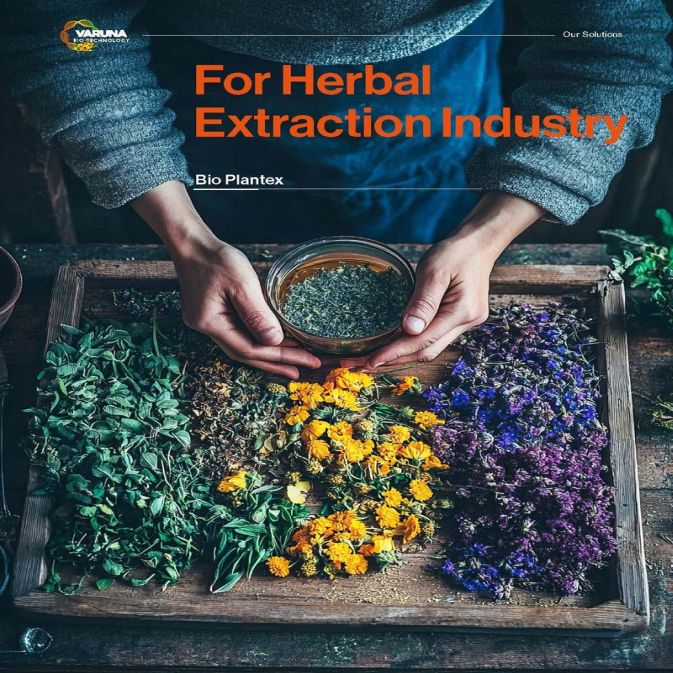
High-purity herbal extracts powered by biotechnology
The herbal extraction industry involves the extraction of active ingredients, compounds, and bioactive substances from plants and herbs for use in various industries such as pharmaceuticals, nutraceuticals, cosmetics, and food products.
These bio-actives are contained in complexed macromolecules such as flavnoids, Terpenes, Tannins, Saponins, Proteins, Carbohydrates, Oils, Volatile matters and other organic and inorganic compounds. These bio-actives are not loosely bound rather they are complexed /bound to lignins, pectins, xylans, polysaccharides etc.
Enzymatic extraction is a modern, eco-friendly technique that uses specific enzymes to break down plant cell walls and release bioactive compounds. This method is widely used in the extraction of valuable compounds from plant materials, such as polysaccharides, proteins, phenolic compounds, and essential oils. Enzymes like cellulase, pectinase, hemicellulose, and protease are added to plant material, which catalyzes the breakdown of complex plant cell structures. These enzymes target specific bonds in the cell wall components, such as cellulose, hemicellulose, or pectin, allowing for easier release of bioactive compounds. This method of extraction has an advantage over traditional method of extraction as it is eco-friendly as no toxic solvents are used, making the process safer and more environmentally friendly. Enzymatic methods have lower energy requirements due to mild operating conditions (room temperature, atmospheric pressure). Enzymes specifically target cell wall components, improving the extraction efficiency and yield of the desired compounds.Extracts are often purer since the breakdown of cell walls allows for a more selective release of bioactive ingredients. This method Operates under mild conditions (low temperature, neutral pH), which helps preserve sensitive bioactive compounds that may degrade at high temperatures or in harsh solvents.Enzymatic reactions can accelerate the breakdown of cell walls compared to mechanical or chemical methods, reducing extraction time. Enzymatic method is very versatile as it Can be applied to a wide range of plant materials (fruits, vegetables, medicinal plants, etc.) for extracting a variety of compounds.
Bio Plantex: Bio Plantex is an innovative enzymatic Bio-processing product to improve herbal extraction. Bio Plantex is a bio-product designed with the aim for pre-treatment of natural plant materials which helps in improving the yield of extraction of Bio-actives in all kinds of extraction processes like distillation, aqueous extraction, solvent extraction etc. with preservation of all the bio-actives.
Effluent Treatment
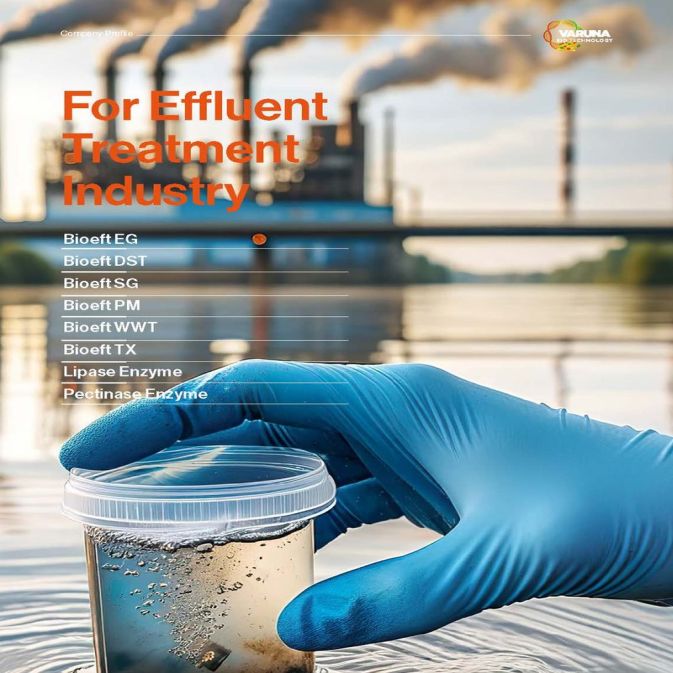
Cleaner water, healthier planet. The Power of Enzymes.
The effluent treatment industry plays a critical role in managing and mitigating the environmental impact of industrial processes by treating wastewater before it is discharged into the environment. With growing concerns over water pollution, resource scarcity, and stringent environmental regulations, the effluent treatment sector has become a vital part of industries such as chemicals, textiles, pharmaceuticals, food and beverage, and energy.
Key components of the Effluent Treatment Industry:
Types of Effluents:
Industrial Effluents: Wastewater discharged from manufacturing processes, typically containing harmful chemicals, heavy metals, oils, and organic pollutants. Common sources include industries like textiles, petrochemicals, pharmaceuticals, and food processing.
Municipal Effluents: These include domestic sewage and wastewater from urban areas, containing organic matter, nutrients (like nitrogen and phosphorus),and pathogens.
Agricultural Effluents: Water runoff from agricultural activities that often contains pesticides, fertilizers, and organic waste from livestock farming.
Effluent Treatment Processes: Effluent treatment plants (ETPs) typically use a combination of physical, chemical, and biological processes to remove contaminants from wastewater:
- Primary treatment: Involves the removal of solid particles through screening and sedimentation. Coagulation and flocculation agents may also be used to help settle suspended solids.
- Secondary treatment: Focuses on reducing organic matter using biological processes, such as activated sludge, biofilters, or membrane bioreactors.
Bioeft EG: Bioeft EG is an optimized effluent treatment formulation for protein(eggs/meat) based industry. It is the synergistic blend of specially screened beneficial and safe organisms, micro and macro nutrients, bio- additives with optimized non-pathogenic microbial flora in organic effluence.
Bioeft DST: Bioeft DST is a effluent treatment solution for septic tanks. It is a synergistic blend of natural bio-catalysts capable of hydrolyzing macro molecules like fat, proteins, polysaccharides and microbial loads in septic tanks.
Bioeft PM: Bioeft -PM is a well-studied product for effluent treatment solution for press mud. Bioeft PM converts press mud into biofertilizer by its screened microorganisms, micro and macro nutrients and bio-additives. Bioeft Pm accelerates decomposition of organic waste along with reduction in obnoxious odor.
Bioeft SG: Bioeft SG is an effluent treatment solution for the sugar industry. It is an optimized effluent treatment formulation for sugar industry for the treatment of ETP/USAB/Aeration tank, Distilleries,Biogas plant and Spent wash. Bacteria in Bioeft SG produces various enzymes capable of breaking down complex compounds to simpler ones hence degrades the organic waste more rapidly and efficiently.
Bioeft WWT: Our advanced bio-culture for wastewater treatment is a specially formulated blend of robust, naturally occurring microorganisms designed to accelerate the breakdown of organic waste, fats, oils, and grease(FOG). It enhances biological treatment efficiency, reduces sludge volume, controls odour, and improves effluent quality in municipal and industrial wastewater systems. Ideal for STPs, ETPs, and decentralized treatment units, this eco-friendly solution ensures compliance with discharge norms while lowering operational costs.
Bioeft TX: Our specialized bio-culture for textile effluent treatment is engineered to effectively degrade high concentrations of dyes, surfactants, and complex organic compounds commonly found in textile wastewater.This robust microbial formulation improves COD/BOD reduction, controls colour and odour, and enhances the performance of biological treatment systems. It supports consistent compliance with environmental discharge standards while reducing sludge formation and operating costs.
Lipases: Lipase are hydrolytic enzymes that catalyse the breakdown of triglycerides into glycerol and free fatty acids. These enzymes exhibit broad substrate specificity and operate effectively at oil–water interfaces, making them valuable in industries that deal with fats and oils. Lipases also support esterification and transesterification reactions, expanding their utility into biosynthesis and green chemistry.
Pectinases: Pectinases are a group of enzymes that catalyse the degradation of pectic substances, particularly pectin, a structural polysaccharide found in the middle lamella and primary cell walls of plants. Pectinases include polygalacturonase, pectin lyase, and pectinesterase, and are essential in industries requiring the clarification, extraction, and processing of plant-based materials.
Contact Us
Varuna Biocell Private Limited
B 1/84-P, Ravindrapuri Extension, Varanasi, , Uttar Pradesh - 221005, India
Call Us : View Mobile Number
E-mail : hello@varunabiotech.com
